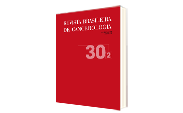Aplicação da Laranja de Acridina. Método Auxiliar Comparativo em Estudos de Fluorescência
DOI:
https://doi.org/10.32635/2176-9745.RBC.1984v30n2.3375Keywords:
Acridine Orange, Microscopy, Fluorescence, Breast NeoplasmsAbstract
This study concerns application of acridine orange by fluorescence microscopy in frozen sections of tissue from malignant human breast biopsies. The obtained data, have shown that since cancer cells are quickly and easlly distinguished by AO fluorescency, this method can be useful as a rapid and accurate screening technique, when the specialist has cumulativa experience and good judgment oi some morphological criteria. In addition, the color shades obtained by AO may give more detail in respect to metachromatic color differentiation of DNA and RNA in normal and abnormal celular elements. This method may be relevant to characterize the percentage of cancer cells which exhibit celular fluorescence induced by biological markers of cancer.
Downloads
References
GILL, J.E.; HORAN, P.K.; WHEELESS JR., L.L. — Cytofiuorometric and Cytochemical comparison of normal and abnormal human cells. J. Cell. Biol., 70:100a, 1976.
GILL, J.E.; WHEELESS, JR., L.L.; HANNA-MADDEN, C.; MARISA, R.J.; HORAN, P.K.-A comparison of Acridine Orange and Feulgen cytochemistry of human tumor cell nuclei. Cancer Research, 38; 1983-1898, 1978.
KASTNER, M.R.Q.; SCHETTINO, A.M.S.; GUERRA, S.O.; CASTRO, O.F. — Determinação de Receptores Hormonais em Câncer de Mama: Método histoquímico. Rev. Bras. De Cancerologia 29 (3):32-39, 1983.
OLSZEWSKI, W.; DARZYNKIE-WICZ, Z.; ROSEN, P.; SCHWARTZ, M.K.; MELAMED, M.R. – Flow Cytometry of Breast Carcinoma. Relation of DNA Ploidy Level to Histology and Estrogen Receptor. Cancer, 48 S80-984, 1981. DOI: https://doi.org/10.1002/1097-0142(19810815)48:4<980::AID-CNCR2820480421>3.0.CO;2-7
SCHÜMMELFEDER, N. - Zur histochemischen Bedeutung der Fluoreszenz-Metachromasie des Acridino range. Acta histochem, Suppl 1: 148-151, 1958.
SCHÜMMELFEDER, N.; WESSEL,W.; NESSEL, E. — Die Wirkung von 3,6-Diaminoacridin auf Wachstum und Zeliteilung in Ehrlich-Ascitestumor. Z. Krebsforsch., 63:129-141, 1959. DOI: https://doi.org/10.1007/BF00531585










